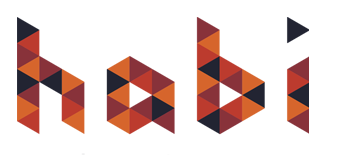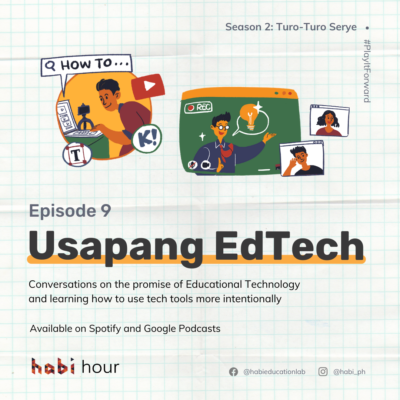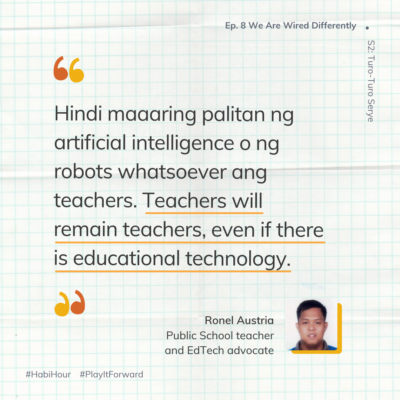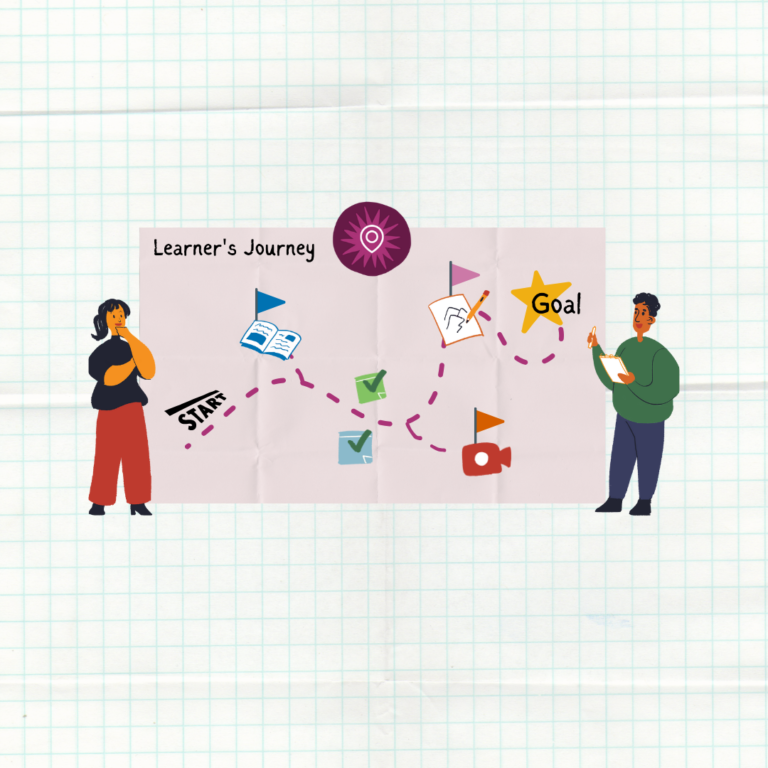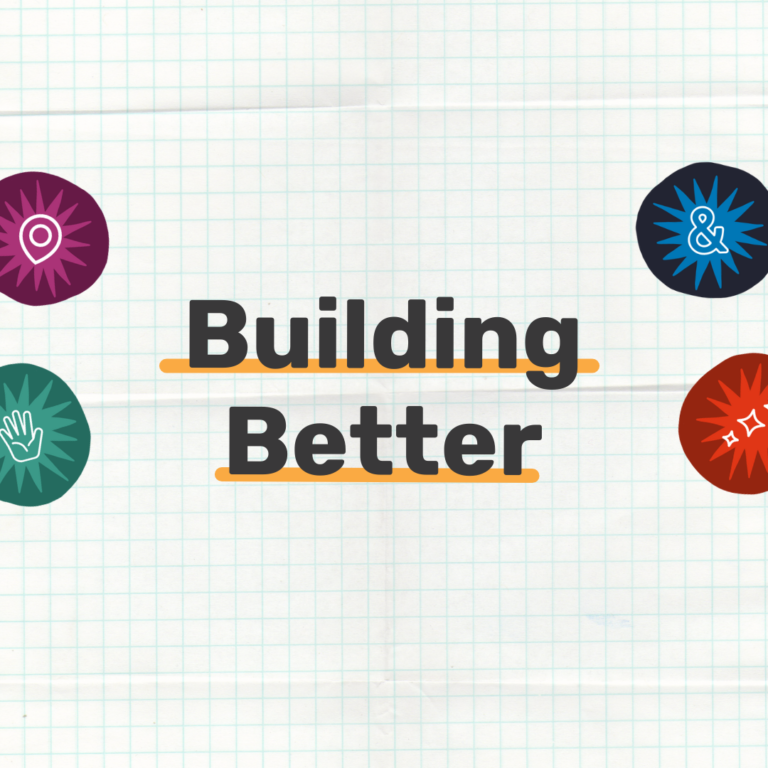Conversations on the promise of Educational Technology and learning how to use tech tools more intentionally
Overview
4 June 2021 | 15 min and 50s
It’s been over a year since the COVID-19 pandemic has changed the way we live. One thing that we’ve noticed is how the pandemic has pushed almost everyone to use technology a lot more than we used to. In this Episode of Habi Hour, we listen to Kaye, Ronel, and Jarrent share their thoughts and experiences in using Educational Technology (EdTech) in a creative and purposeful manner to enrich the learning experiences of students and teachers alike. While this episode is particularly useful for teachers, this conversation is also for anybody who works from home and uses technology in meetings or collaborative work.
Curious about the Digital Tayo course packs? Join JEEP here.
Transcript
Introductions and Check In
JARRENT: Ako at this point uh ako ay isang television. Puwedeng LED or whatever because it’s already 4:00 and I feel like it’s the end of the day and it’s time for relaxing. Magne-Netflix na ako eventually.
RONEL: Ako obviously yung suot-suot ko ngayon na gaming headset. Why? It’s because to convey the ideas clearly and to hear my voice as well.
KAYE: That was Sir Jarrent and Sir Ronel, EdTech teachers and advocates, checking into our conversation by sharing what tech tool they felt like on the day of our recording. Kayo, what tech tool do you feel like now as you’re joining us?
Ako, I feel like Padlet. It’s a virtual bulletin board that we can use to share ideas and collaborate with other people.
I’m Kaye, a Learning Experience Designer from Habi. The three of us recently worked together on a project for Facebook called Digital Tayo, to develop what we call course packs that can be used to teach three new EdTech subjects in higher education. What we realized over the course of this project is that no matter who you are or what sector you work in, the COVID-19 pandemic has forced us to rely on technology a lot more than we used to.
In this episode we’ll try answering this question: How might we ensure that more than using technology creatively, we are purposeful about it too?
[Habi Hour Intro Spiel]
Kuwentuhan
KAYE: Bago tayo magsimula, mahalagang magkaroon tayo ng alignment – ano nga ba ang Educational Technology o EdTech? Ano ang madalas natin naiisip pag naririnig natin ang term na ito? Meron bang mga common misconceptions?
JARRENT: Educational Technology is basically the utilization of whatever technology you have – it doesn’t have to be the high-end technology that we know. Kasi a lot of students would have that notion na when it comes to EdTech you need to make use of the high-end technology. Kailangan sophisticated software and all. That’s just one part. That’s just one part of educational technology. More importantly, it’s how you use technology in order to enrich the teaching and learning process.
RONEL: It’s a systematic application of relevant technological processes and resources in teaching [so] with the goal of [to] improve the student’s performance. It involves also a disciplined approach, identifying the needs and applying technology in instruction. To be short and simple, it’s the manipulation of technology for the benefit of quality and relevant education.
In the basic ed, ang tawag namin diyan ay ICT Integration. They are present in any demonstration that we have. Yung misconception kasi ay pag si teacher gumamit ng Powerpoint, that’s ICT integration, Educational Technology na. But if we have a deeper understanding of that, makikita natin talaga na dapat how the student manipulate or harness the skills in using ICT or Edtech. Dapat may interaction – hindi lang si teacher ang nagbibigay ng EdTech…
JARRENT: Totoo yun, pag nago-observe ka ng mga classes, pag nag-Powerpoint na sila or nagpalabas ng video “o, EdTech na yan!” Napaka-ganda na ng integration. Pero mapapansin mo na wala namang kaibahan yung gumamit siya ng slide sa gumamit siya ng whiteboard tapos sinulat niya. Kasi ‘pag nakita mo yung slides niya, ‘yung powerpoint slides niya, it’s just text, it’s the same. So paano mo na-enrich yung learning process?
KAYE: So – alam na natin na ang EdTech ay hindi lamang pag-gamit ng technology sa loob ng classroom. It’s the systematic and intentional integration of technology to enhance the teaching and learning process.
What’s it like being an EdTech teacher in the time of remote learning? Ano ang mga unique challenges or responsibilities na meron ang isang EdTech teacher?
RONEL: Pag nabanggit na Edtech teacher ka or teacher ng technology sasabihin nila “ay ang techie-techie mo naman.” ‘Yung millenial term na “masyado kang techie/advanced” ‘Yung gadget mo, palaging up to date. Then hindi ka mabubuhay nang wlang laptop. Pero isa rin sigurong sign na isa kang EdTech teacher, or connotation niyan ay you are versatile enough to meet the challenges in these changing times.
JARRENT: Sa amin naman, pag nalaman nila na nagha-handle ka ng EdTech, other teachers would often rely on you for support. Halimbawa, in the use of the learning management system. Alam nila na edtech teacher ka, iniisip nila alam mo siya i-navigate. Alam mo yung mga technicalities niya. O kaya naman simpleng spreadsheet, namo-mroblema sila kung paano gamitin yung formula, sayo sila nagre-rely. Siguro ang magandang tingnan is the opportunity for you to empower these teachers na din. Dahil ikaw yung go-to person nila. Isa siyang opportunity para i-encourage mo rin sila na matutunan kung ano ang alam mo.
RONEL: In teaching EdTech nowadays must be an advocacy. Hindi lang natatapos na naituro na natin. The essential objective of Edtech is to improve the quality of education and enhance the learning process. I hope EdTech in the near future will lessen the digital divide that we are experiencing right now. Mas maganda na inclusive siya in the sense na lahat ng bata, mag-aaral man, regardless of their age, race, gender, etc., mas may access in delivering quality education technology.
KAYE: Ano ang nagiging value or impact sa classroom or any learning space pag purposeful ang paggamit ng EdTech?
JARRENT: One good thing about educational technology is that it facilitates immediate feedback. It allows you to provide immediate feedbacking. For example, dati, when you ask students to take a quiz, you administer the quiz sa face-to-face class mo, you have to collect the papers, tapos spend some hours checking one by one. Tapos record the scores. Then after that you have to analyze the scores to check sino yung mababa, sino mataas. Kung natapos mo ng gabi, you can give back the papers the next day. Tapos dun ka pa lang magbibigay ng feedback. Pero sa EdTech, kung meron kang isang software na kaya mag-generate ng quiz, then students can take the quiz, and then immediately see their scores, you can actually see the analytics, makikita mo kung ano yung level of difficulty ng test, makakapag-bigay ka agad ng feedback. Aside from the fact na dumali yung buhay natin kasi hindi mo na kailangan mag mano y mano ng checking. Ang gusto natin, yung estudyante kaya niyang maging independent sa kanyang learning. At part ng pagiging independent na ‘yon, kailangan gabayan natin siya through immediate feedback. Kung ang feedback natin ay nade-delay hindi alam ng bata kung magp-proceed ba siya o hindi.
KAYE: When EdTech is used purposefully, we can accomplish many of our teacher tasks, or any task, more easily. And when teachers have it easier, students often have it easier too.
RONEL: For me as a social science teacher and an edtech advocate – napansin ko yung behavior ng students. Nung face-to-face clasess, meron diyang mga shy type na mga bata o yung mga tahimik lang sa isang sulok. And since ganito ang nangyari during the pandemic, we experienced some ** of some virtual platforms, doon ko mas nakita na meron pa lang mga socially active virtually na mga bata. Yung behavior nila nag-iba na mas active in a virtual platform rather than in a face-to-face classes.
JARRENT: Kung titingnan natin, iisa lang naman ang gusto ng lahat—whether it’s the Department of Education, Commission on Higher Education, or even the classroom teachers—gusto natin maturuan lahat ng mga estudyante natin nasaan man sila. And I think technology could become an equalizer in that essence. Ang isang bata na nasa malayong lugar, kung sana magkakaroon lang siya ng oportunidad maka-connect sa internet, hindi niya kailangan maglakad ng pagka-layo-layo para lang mag-attend sa klase niya. Hindi niya kailangang makipagsiksikan sa isang crowded classroom para lang makinig sa discussion ng teacher niya.
JARRENT: Pag binibigyan mo sila ng opportunity i-navigate yung technologies na ito, they eventually come up with products/outputs that are beyond your expectations.
KAYE: The purposeful and intentional use of EdTech can also make learning more inclusive.
But of course, using technology for teaching and learning doesn’t immediately mean we’re getting the benefits. So here are some of Sir Jarrent and Sir Ronel’s tips for learning how to use educational technology more intentionally.
RONEL: First begin with the end in mind. Alamin natin ang learning objectives and goals. Ano ba ang gusto nating palabasin sa ating lesson o yung output na makukuha natin. Maging mapanuri tayo, maging maingat tayo sa pag-gamit dahil too much technology sometimes can lead us in an inconvenient way.
JARRENT: It doesn’t matter if you know a very sophisticated or very complex technology, gadget, software, or program. If you don’t know how to use it, to align it to the purpose or to the goal of the lesson, if you don’t know how to match it with the certain strategy that you’re planning to use for teaching a certain lesson, it would not really have so much influence.
KAYE: Tip number 1 – start with the learning objectives before selecting your tools. When our goals and intentions are clear, it becomes easier to look for tools that will support us in reaching for them.
JARRENT: Know your learners as well. Dapat kilala mo yung mo yung mga estudyante mo. Katulad naman ng face to face, we need to understand our learners, ano yung pinanggagalingan nila.
Make sure that you have alternatives. Because you have to understand that not all students may be able to use that. Kasi may mga limitations sa gadget nila, baka hindi kaya i-support ng gadget nila yung application na ‘yon. Papasok ka ngayon para maghanap ng alternatives. Pero ang alternatives mo, anchored pa rin sa objectives.
KAYE: Tip number 2 – get to know your learners. What devices can they use for class? What resources or platforms are easy for them to access and navigate? Do they have a steady internet connection? These are questions that can help you look for alternative tools and strategies that are suited to their needs.
RONEL: Idagdag ko na rin siguro isang misconception or fear, di ko naman nilalahat yung mga teachers, pero yung mga medyo may edad na, nahihirapan silang mag-manipulate ng technology. But in a simple way that how they can convey or harness technology to simplify their work is a form of EdTech also. Maari tayong mag join or collaborate with some support groups in EdTech, so be willing to teach and mentor those who are in need of our support. ‘Wag rin tayong madamot, let’s share our blessing in teaching EdTech.
KAYE: Tip number 3 – be open to learning something new. Learning how to use technology purposefully takes a lot of practice. Don’t be afraid to explore, and to ask your colleagues for support. You can even ask your students for tips – they might know of tools and strategies that would work for them.
And speaking of asking your colleagues – If you’re an EdTech teacher or practitioner looking for a community of like-minded people who want to improve teacher education through creative, inclusive, and safe tech integration, we’d like to invite you to a Facebook group called JEEP: Joint EdTech Educators of the Philippines. Look for JEEPEDTECH on Facebook or check out the link in the episode description and you just might find your tribe.
JARRENT: Medyo backward yung thinking na “okay kunin natin lahat ng gadget, lahat ng technology. Minsan sa schools nangyayari din yan pag nagbibigay ako ng teacher training. Gusto nila “magpurchase tayo ng ganito, laptop, whiteboard.” Pero hindi nila nako-consider paano mo ba ito gagamitin, kasi yun yung pinakamahalaga, baka you’re just wasting resources investing on this and yet in the end, hindi magamit ng mga teachers para sa purpose or goal na gusto nilang gawin.
RONEL: Hindi maaaring palitan ng artificial intelligence, o ng robots whatsoever ang teachers. Teachers will remain teachers as well, even if there is educational technology.
KAYE: And last tip – when investing in technology, don’t forget to invest in ourselves as educators as well.
When our students graduate and eventually go on to achieve success, they won’t remember the fancy software and applications we used, or the funny gifs on our slideshows. They’ll remember their teachers, and how we designed learning experiences that made them feel valued and included.
As the pandemic continues, I hope this episode was a reminder to keep our learners at the heart of everything we do as teachers.
[Habi Hour Outro]
